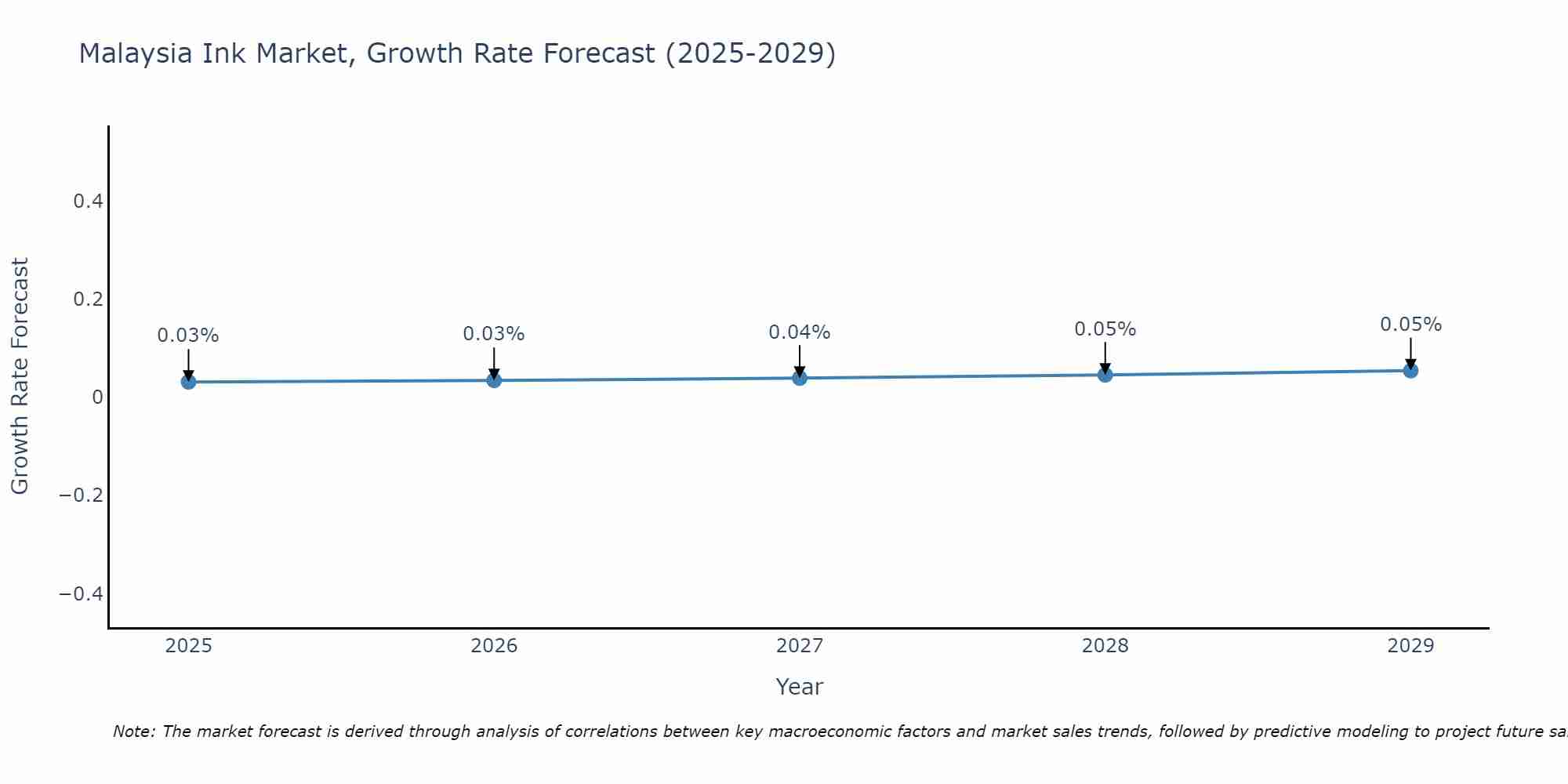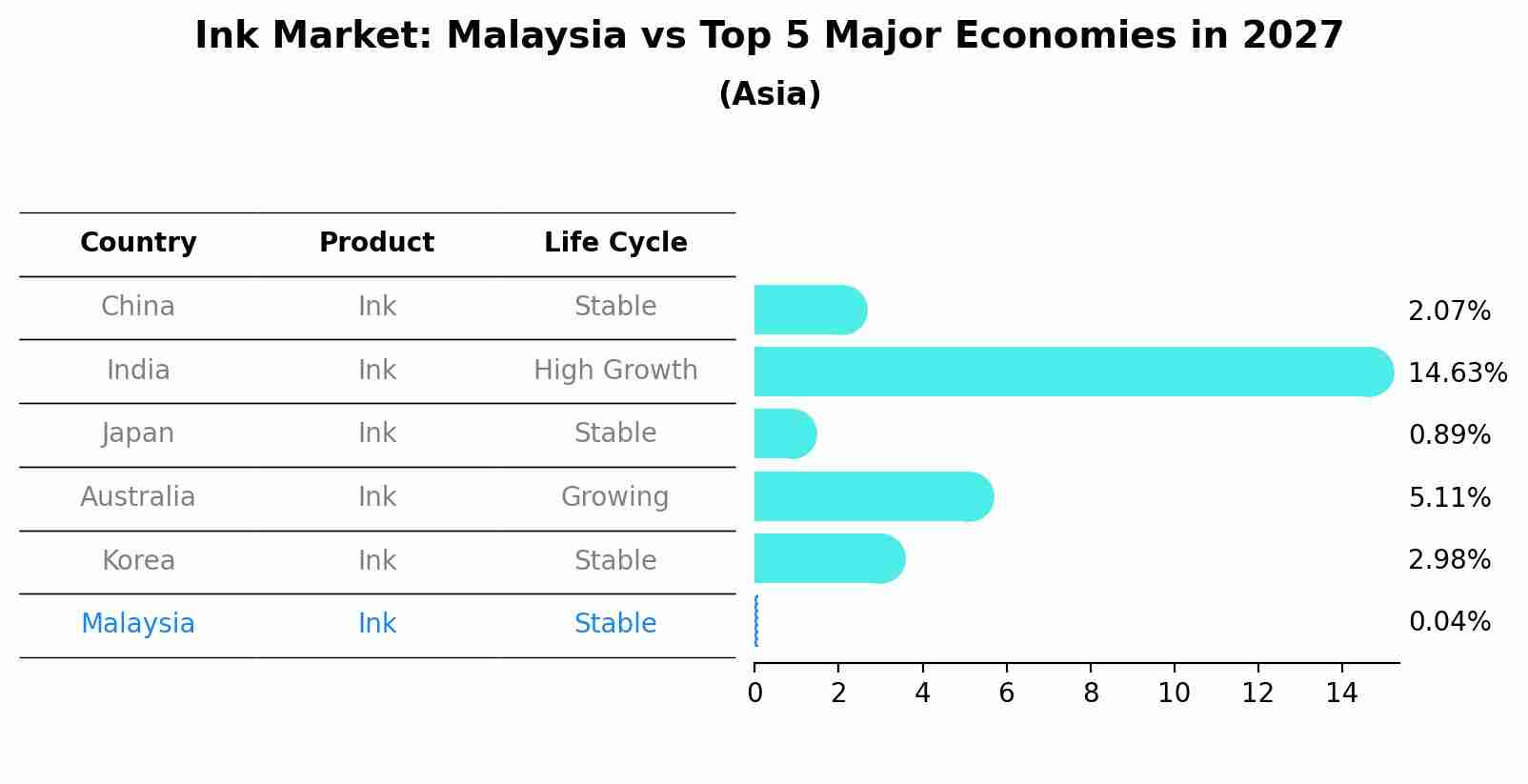Malaysia Ink Market (2025-2031) Outlook | Industry, Growth, Forecast, Share, Trends, Value, Companies, Size, Analysis & Revenue
| Product Code: ETC253346 | Publication Date: Aug 2022 | Updated Date: Apr 2025 | Product Type: Market Research Report | |
| Publisher: 6Wresearch | No. of Pages: 75 | No. of Figures: 35 | No. of Tables: 20 | |
Malaysia Ink Market Size Growth Rate
The Malaysia Ink Market is poised for steady growth rate improvements from 2025 to 2029. The growth rate starts at 0.03% in 2025 and reaches 0.05% by 2029.

Ink Market: Malaysia vs Top 5 Major Economies in 2027 (Asia)
In the Asia region, the Ink market in Malaysia is projected to expand at a stable growth rate of 0.04% by 2027. The largest economy is China, followed by India, Japan, Australia and South Korea.

Malaysia Ink Market Synopsis
The Malaysia ink market is driven by a combination of factors, including the printing industry`s growth, increasing demand for packaging solutions, and a rising interest in creative arts and crafts. With the expansion of the e-commerce sector and the need for attractive packaging, ink consumption in the packaging segment is likely to rise. Additionally, the growth of the education and publishing sectors contributes to the demand for printer inks. To meet evolving consumer preferences, manufacturers are investing in eco-friendly and high-quality ink formulations. Overall, the Malaysia ink market is anticipated to maintain a steady growth trajectory, driven by diverse applications and technological innovations.
Drivers of the Market
The Malaysia ink market is influenced by the printing and packaging industry, which continues to evolve in response to changing consumer preferences and technological advancements. The demand for high-quality inks for various printing applications remains robust. Additionally, the growing e-commerce sector has increased the need for efficient packaging and labeling, further boosting the ink market`s prospects.
Challenges of the Market
The Malaysia ink market faces challenges due to the digitalization of various industries. As businesses transition to digital communication and documentation, the demand for traditional printing ink has declined. Ink manufacturers must diversify their product offerings by exploring opportunities in the digital inkjet and specialty ink segments. Additionally, they should focus on sustainability, as eco-friendly inks are gaining traction in response to environmental concerns.
COVID 19 Impact on the Market
In the ink market, the pandemic had mixed effects. While there was a surge in demand for inks related to packaging and labeling as e-commerce and food delivery services thrived, the market for inks used in the publishing and advertising sectors faced challenges. Print media saw a decline in demand as businesses reduced their advertising budgets and consumers shifted towards digital platforms. Moreover, disruptions in the supply chain affected the availability of certain ink components, leading to price fluctuations.
Key Players in the Market
The Malaysia ink market includes prominent players like DIC Corporation, Toyo Ink Group, and Sakata INX. These companies offer a wide range of inks for various applications, including packaging, printing, and industrial use.
Key Highlights of the Report:
- Malaysia Ink Market Outlook
- Market Size of Malaysia Ink Market, 2024
- Forecast of Malaysia Ink Market, 2031
- Historical Data and Forecast of Malaysia Ink Revenues & Volume for the Period 2021-2031
- Malaysia Ink Market Trend Evolution
- Malaysia Ink Market Drivers and Challenges
- Malaysia Ink Price Trends
- Malaysia Ink Porter's Five Forces
- Malaysia Ink Industry Life Cycle
- Historical Data and Forecast of Malaysia Ink Market Revenues & Volume By Technology for the Period 2021-2031
- Historical Data and Forecast of Malaysia Ink Market Revenues & Volume By Lithographic for the Period 2021-2031
- Historical Data and Forecast of Malaysia Ink Market Revenues & Volume By Flexographic for the Period 2021-2031
- Historical Data and Forecast of Malaysia Ink Market Revenues & Volume By Gravure for the Period 2021-2031
- Historical Data and Forecast of Malaysia Ink Market Revenues & Volume By Digital for the Period 2021-2031
- Historical Data and Forecast of Malaysia Ink Market Revenues & Volume By Letterpress for the Period 2021-2031
- Historical Data and Forecast of Malaysia Ink Market Revenues & Volume By Others for the Period 2021-2031
- Historical Data and Forecast of Malaysia Ink Market Revenues & Volume By Ink Type for the Period 2021-2031
- Historical Data and Forecast of Malaysia Ink Market Revenues & Volume By Oil Based for the Period 2021-2031
- Historical Data and Forecast of Malaysia Ink Market Revenues & Volume By Solvent Based for the Period 2021-2031
- Historical Data and Forecast of Malaysia Ink Market Revenues & Volume By Water Based for the Period 2021-2031
- Historical Data and Forecast of Malaysia Ink Market Revenues & Volume By Applications for the Period 2021-2031
- Historical Data and Forecast of Malaysia Ink Market Revenues & Volume By Label And Packaging for the Period 2021-2031
- Historical Data and Forecast of Malaysia Ink Market Revenues & Volume By Commercial Printing for the Period 2021-2031
- Historical Data and Forecast of Malaysia Ink Market Revenues & Volume By Publications for the Period 2021-2031
- Historical Data and Forecast of Malaysia Ink Market Revenues & Volume By Others for the Period 2021-2031
- Malaysia Ink Import Export Trade Statistics
- Market Opportunity Assessment By Technology
- Market Opportunity Assessment By Ink Type
- Market Opportunity Assessment By Applications
- Malaysia Ink Top Companies Market Share
- Malaysia Ink Competitive Benchmarking By Technical and Operational Parameters
- Malaysia Ink Company Profiles
- Malaysia Ink Key Strategic Recommendations
Frequently Asked Questions About the Market Study (FAQs):
1 Executive Summary |
2 Introduction |
2.1 Key Highlights of the Report |
2.2 Report Description |
2.3 Market Scope & Segmentation |
2.4 Research Methodology |
2.5 Assumptions |
3 Malaysia Ink Market Overview |
3.1 Malaysia Country Macro Economic Indicators |
3.2 Malaysia Ink Market Revenues & Volume, 2021 & 2031F |
3.3 Malaysia Ink Market - Industry Life Cycle |
3.4 Malaysia Ink Market - Porter's Five Forces |
3.5 Malaysia Ink Market Revenues & Volume Share, By Technology, 2021 & 2031F |
3.6 Malaysia Ink Market Revenues & Volume Share, By Ink Type, 2021 & 2031F |
3.7 Malaysia Ink Market Revenues & Volume Share, By Applications, 2021 & 2031F |
4 Malaysia Ink Market Dynamics |
4.1 Impact Analysis |
4.2 Market Drivers |
4.3 Market Restraints |
5 Malaysia Ink Market Trends |
6 Malaysia Ink Market, By Types |
6.1 Malaysia Ink Market, By Technology |
6.1.1 Overview and Analysis |
6.1.2 Malaysia Ink Market Revenues & Volume, By Technology, 2021-2031F |
6.1.3 Malaysia Ink Market Revenues & Volume, By Lithographic , 2021-2031F |
6.1.4 Malaysia Ink Market Revenues & Volume, By Flexographic , 2021-2031F |
6.1.5 Malaysia Ink Market Revenues & Volume, By Gravure, 2021-2031F |
6.1.6 Malaysia Ink Market Revenues & Volume, By Digital, 2021-2031F |
6.1.7 Malaysia Ink Market Revenues & Volume, By Letterpress, 2021-2031F |
6.1.8 Malaysia Ink Market Revenues & Volume, By Others, 2021-2031F |
6.2 Malaysia Ink Market, By Ink Type |
6.2.1 Overview and Analysis |
6.2.2 Malaysia Ink Market Revenues & Volume, By Oil Based, 2021-2031F |
6.2.3 Malaysia Ink Market Revenues & Volume, By Solvent Based, 2021-2031F |
6.2.4 Malaysia Ink Market Revenues & Volume, By Water Based, 2021-2031F |
6.3 Malaysia Ink Market, By Applications |
6.3.1 Overview and Analysis |
6.3.2 Malaysia Ink Market Revenues & Volume, By Label And Packaging, 2021-2031F |
6.3.3 Malaysia Ink Market Revenues & Volume, By Commercial Printing, 2021-2031F |
6.3.4 Malaysia Ink Market Revenues & Volume, By Publications, 2021-2031F |
6.3.5 Malaysia Ink Market Revenues & Volume, By Others, 2021-2031F |
7 Malaysia Ink Market Import-Export Trade Statistics |
7.1 Malaysia Ink Market Export to Major Countries |
7.2 Malaysia Ink Market Imports from Major Countries |
8 Malaysia Ink Market Key Performance Indicators |
9 Malaysia Ink Market - Opportunity Assessment |
9.1 Malaysia Ink Market Opportunity Assessment, By Technology, 2021 & 2031F |
9.2 Malaysia Ink Market Opportunity Assessment, By Ink Type, 2021 & 2031F |
9.3 Malaysia Ink Market Opportunity Assessment, By Applications, 2021 & 2031F |
10 Malaysia Ink Market - Competitive Landscape |
10.1 Malaysia Ink Market Revenue Share, By Companies, 2024 |
10.2 Malaysia Ink Market Competitive Benchmarking, By Operating and Technical Parameters |
11 Company Profiles |
12 Recommendations |
13 Disclaimer |
- Single User License$ 1,995
- Department License$ 2,400
- Site License$ 3,120
- Global License$ 3,795
Search
Related Reports
- Portugal Electronic Document Management Market (2025-2031) | Strategy, Consumer Insights, Analysis, Investment Trends, Opportunities, Growth, Size, Share, Industry, Revenue, Segments, Value, Segmentation, Supply, Forecast, Restraints, Outlook, Competition, Drivers, Trends, Demand, Pricing Analysis, Competitive, Strategic Insights, Companies, Challenges
- France Electronic Document Management Market (2025-2031) | Strategy, Consumer Insights, Analysis, Investment Trends, Opportunities, Growth, Size, Share, Industry, Revenue, Segments, Value, Segmentation, Supply, Forecast, Restraints, Outlook, Competition, Drivers, Trends, Demand, Pricing Analysis, Competitive, Strategic Insights, Companies, Challenges
- Portugal Occupational Health & Safety Services Market (2025-2031) | Strategy, Consumer Insights, Analysis, Investment Trends, Opportunities, Growth, Size, Share, Industry, Revenue, Segments, Value, Segmentation, Supply, Forecast, Restraints, Outlook, Competition, Drivers, Trends, Demand, Pricing Analysis, Competitive, Strategic Insights, Companies, Challenges
- Netherlands Occupational Health and Safety Services Market (2025-2031) | Strategy, Consumer Insights, Analysis, Investment Trends, Opportunities, Growth, Size, Share, Industry, Revenue, Segments, Value, Segmentation, Supply, Forecast, Restraints, Outlook, Competition, Drivers, Trends, Demand, Pricing Analysis, Competitive, Strategic Insights, Companies, Challenges
- Belgium and Luxembourg Facility Management Market (2025-2031) | Strategy, Consumer Insights, Analysis, Investment Trends, Opportunities, Growth, Size, Share, Industry, Revenue, Segments, Value, Segmentation, Supply, Forecast, Restraints, Outlook, Competition, Drivers, Trends, Demand, Pricing Analysis, Competitive, Strategic Insights, Companies, Challenges
- Russia Women Intimate Apparel Market (2025-2031) | Strategy, Consumer Insights, Analysis, Investment Trends, Opportunities, Growth, Size, Share, Industry, Revenue, Segments, Value, Segmentation, Supply, Forecast, Restraints, Outlook, Competition, Drivers, Trends, Demand, Pricing Analysis, Competitive, Strategic Insights, Companies, Challenges
- Africa Chocolate Market (2025-2031) | Size, Share, Trends, Growth, Revenue, Analysis, Forecast, industry & Outlook
- Global Hydroxychloroquine And Chloroquine Market (2025-2031) | Industry, Trends, Size, Outlook, Growth, Value, Companies, Revenue, Analysis, Share, Forecast
- Saudi Arabia Plant Maintenance Market (2025-2031) | Industry, Size, Growth, Revenue, Value, Companies, Forecast, Analysis, Share & Trends
- Taiwan Electric Truck Market (2025-2031) | Outlook, Industry, Revenue, Size, Forecast, Growth, Analysis, Share, Companies, Value & Trends
Industry Events and Analyst Meet
Our Clients
Whitepaper
- Middle East & Africa Commercial Security Market Click here to view more.
- Middle East & Africa Fire Safety Systems & Equipment Market Click here to view more.
- GCC Drone Market Click here to view more.
- Middle East Lighting Fixture Market Click here to view more.
- GCC Physical & Perimeter Security Market Click here to view more.
6WResearch In News
- Doha a strategic location for EV manufacturing hub: IPA Qatar
- Demand for luxury TVs surging in the GCC, says Samsung
- Empowering Growth: The Thriving Journey of Bangladesh’s Cable Industry
- Demand for luxury TVs surging in the GCC, says Samsung
- Video call with a traditional healer? Once unthinkable, it’s now common in South Africa
- Intelligent Buildings To Smooth GCC’s Path To Net Zero













